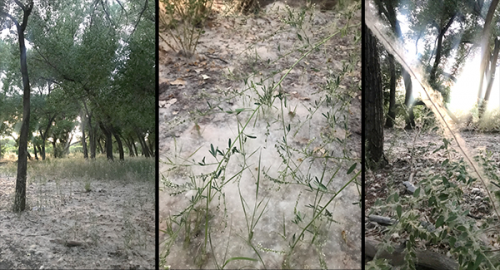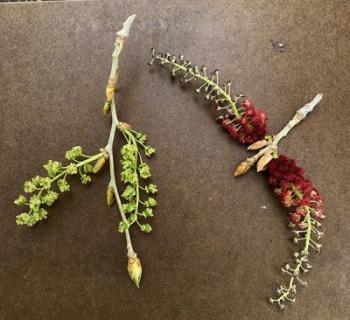April 24, 2021
Cottonwood Cotton and Drought-Friendly Flowers

Reprints by Dr. Curtis Smith, former NMSU Extension Horticulture Specialist (updates and photos by Dr. Marisa Thompson)
Myth Busters: Is Cottonwood Fluff an Allergen? And Do Irises Use Too Much Water?
Is Cottonwood Fluff an Allergen?
Reprinted from May 2003 - Which Cottonwood Makes Cotton?
Question:
I know some cottonwood trees make cottony fluff, and others make pollen. Which is which?
Answer (by Dr. Curtis Smith):
Male cottonwood trees produce pollen, while female trees produce the cottony fluff that we call cotton. That “cotton” is an appendage to help disperse the cottonwood seeds so they do not fall only at the base of the mother tree. Since the seeds are the potential offspring, they are produced from the mother (female) tree. The male varieties of poplar (the genus Populus, which includes cottonwoods) are banned in some municipalities because of the human allergy problems associated with their pollen. Some people do not like the cotton from the female trees. While it doesn't cause allergies, it can clog car radiators, swamp coolers, and swimming pool filters. This cotton is very flammable, so it can be hazardous near flames. This same relationship is true for the junipers. Male junipers make pollen, which causes allergies, while the females make the berry-like cones. To avoid allergies, don't plant the male junipers near your home. Select varieties that produce the berry-like cones. This is all based on the fact that these plants are dioecious. Dioecious is a word that means the male flowers and female flowers are produced on different plants. This is not true of all plants. Most plants have both male and female parts in a single flower (e.g., apple), while a few have separate flowers on the same plant (e.g., pecan).

Do Irises Use Too Much Water?
Many Irises Are Well Adapted to New Mexico Growing Conditions
Question:
I have noticed a lot of beautiful irises in several towns I visited in New Mexico. I thought they required a lot of water. Shouldn't people avoid such high-water plants in New Mexico landscapes?
Answer (by Dr. Curtis Smith):
There are some irises that need considerable water (Louisiana iris), but there are others that are extremely well adapted to New Mexico. The bearded, aril, and spuria irises do well here. They are adapted to the soil, and their growing season is in the early spring when the weather is cool, so irrigation water isn't quickly lost to evaporation. The spuria irises are interesting because they don't need to be divided as often as others, grow taller, and are very elegant looking. The aril varieties are from very arid regions and are especially well adapted to soils and moisture conditions in New Mexico. As I speak to gardeners around the state, I continue to learn. I once complained to an Extension Master Gardener that the problem with irises was that they only bloomed once a year. She has since shown me that there are bearded iris varieties that bloom two or more times a year. Irises are extremely beautiful, easy to grow, and, if the proper types are chosen, very well adapted to New Mexico.

Marisa Y. Thompson, PhD, is the Extension Horticulture Specialist, in the Department of Extension Plant Sciences at the New Mexico State University Los Lunas Agricultural Science Center, email: desertblooms@nmsu.edu, office: 505-865-7340, ext. 113.
Links:
For more gardening information, visit the NMSU Extension Horticulture page at Desert Blooms and the NMSU Horticulture Publications page.
Send gardening questions to Southwest Yard and Garden - Attn: Dr. Marisa Thompson at desertblooms@nmsu.edu, or at the Desert Blooms Facebook page.
Please copy your County Extension Agent and indicate your county of residence when you submit your question!